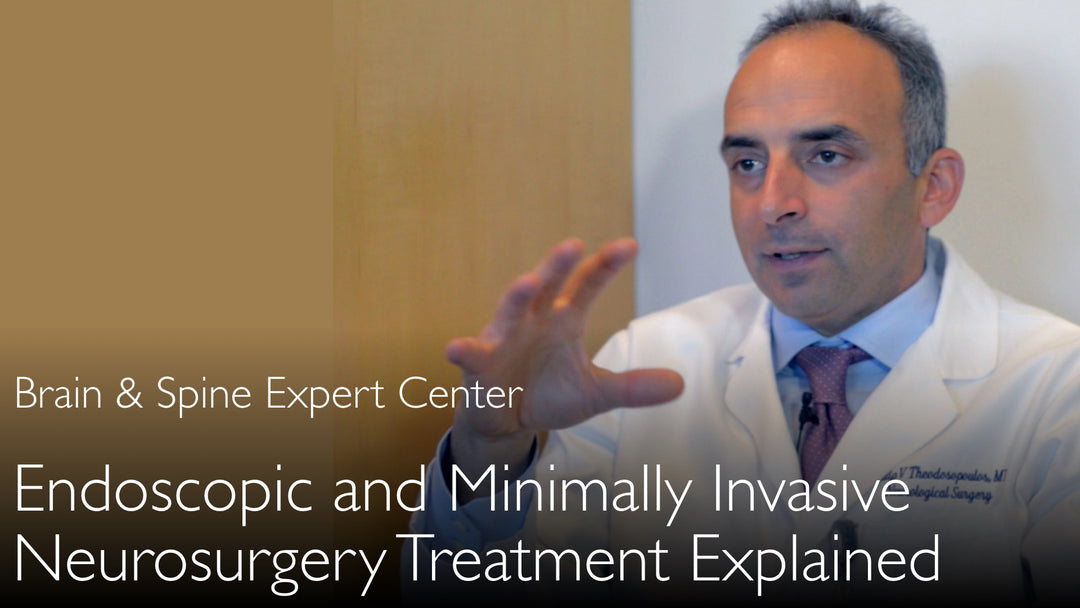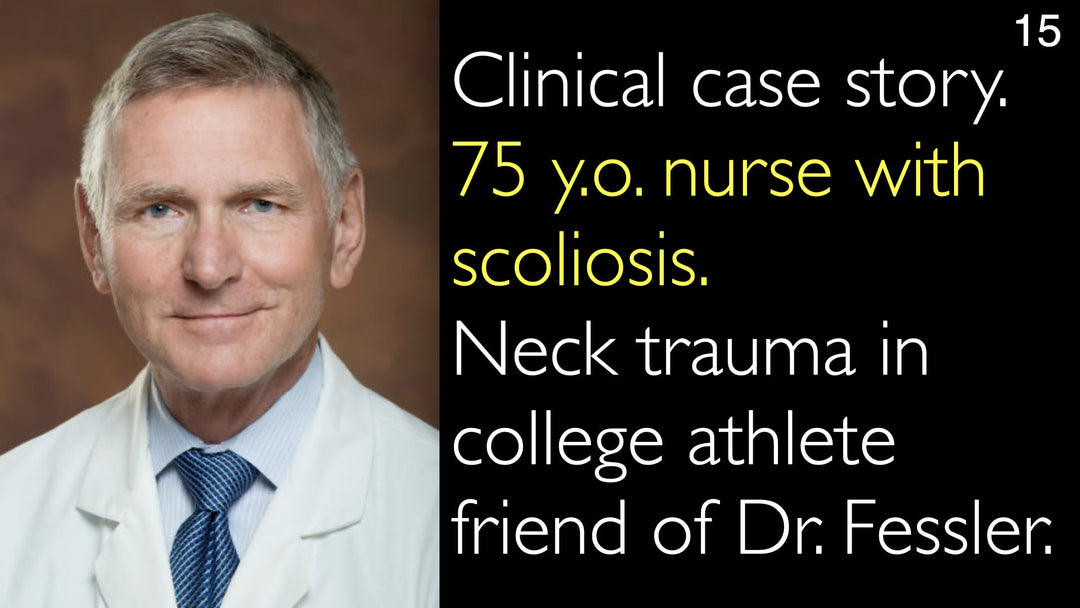Leading expert in minimally invasive neurosurgery, Dr. Philip Theodosopoulos, MD, explains the evolution of endoscopic skull base tumor treatment. He details how new technologies allow surgeons to access deep brain tumors through the nose without external incisions. This approach aims to reduce brain retraction and surgical morbidity. Dr. Philip Theodosopoulos, MD, discusses the balance between innovation and proven effectiveness in complex brain tumor surgery.
Advanced Minimally Invasive Endoscopic Surgery for Skull Base Brain Tumors
Jump To Section
- Skull Base Surgery Challenges
- Radiosurgery Impact on Treatment
- Endoscopic Nose Approach
- New Technology and Tools
- Defining Treatment Indications
- Comparing Surgical Approaches
- Full Transcript
Skull Base Surgery Challenges
Dr. Philip Theodosopoulos, MD, highlights the unique difficulties of skull base neurosurgery. The brain and its critical vascular structures are densely packed inside the immovable skull. Traditional open approaches to deep central tumors often require significant brain retraction. This retraction can come at a high cost of brain tissue damage.
Surgeons historically had to destroy large amounts of bony skull base and underlying soft tissue to access these lesions. Dr. Theodosopoulos confirms that these extensive techniques remain the gold standard for many complex tumors. The primary goal is always complete tumor removal, not just minimizing the incision size.
Radiosurgery Impact on Treatment
The development of radiosurgery was a major impetus for making skull base surgery less invasive. Technologies like Gamma Knife deliver precise, computer-controlled radiation beams. This allows physicians to effectively treat certain brain tumors without any incision at all.
Dr. Philip Theodosopoulos, MD, notes this created a paradigm shift. The field moved from large, disfiguring operations to a non-invasive alternative. This advancement forced neurosurgeons to rethink how they could perform their own procedures in a more minimally invasive way to stay relevant.
Endoscopic Nose Approach
Modern minimally invasive neurosurgery for the skull base is often a "no incision" procedure. Surgeons access the deepest parts of the brain by going through the nose and natural sinuses. This approach enters the skull from its base without any external cuts on the face or head.
Dr. Philip Theodosopoulos, MD, explains that this method utilizes endoscopes instead of microscopes. These long telescopes provide a panoramic, deep inside view of the surgical area. Surgeons can then drill and remove bone to reach the center of the skull, drastically reducing approach-related morbidity.
New Technology and Tools
The shift to endoscopic corridors requires a completely new set of specialized instrumentation. These new pathways are small, narrow, and effective but present unique challenges. Surgeons must operate from 15 to 20 centimeters away from the entry point, demanding advanced skills and tools.
Dr. Philip Theodosopoulos, MD, emphasizes that the technology is only part of the equation. The real challenge is developing the expertise to use these tools safely and effectively. This new technology aims to provide better access to tumors while minimizing collateral damage to healthy brain structures.
Defining Treatment Indications
A critical question in modern neurosurgery is determining which tumors are best suited for endoscopic techniques. The state of the art involves defining the true indications for these minimally invasive approaches. Research focuses on whether these methods offer the same tumor removal effectiveness as traditional surgery.
Dr. Theodosopoulos points out that while less invasive surgery seems intuitively better, this is not always the case. The field is actively working to establish where the line is between benefit and risk. The goal is to ensure that a less invasive approach does not compromise the primary objective of curing the patient.
Comparing Surgical Approaches
Minimally invasive surgery is not limited to endoscopic methods. Dr. Theodosopoulos clarifies that open cranial surgery has also evolved to become less invasive. Surgeons now make smaller incisions, like in the eyebrow, resulting in much smaller openings in the head than in the past.
These refined open techniques serve as an important alternative to purely endoscopic approaches. The decision between an endoscopic procedure and a minimally invasive open craniotomy is complex. Dr. Anton Titov, MD, and Dr. Philip Theodosopoulos, MD, agree that the best approach is tailored to the specific tumor and patient anatomy.
Full Transcript
Dr. Anton Titov, MD: Minimally invasive techniques are a very strong trend in modern surgery in various subspecialties. Endoscopic and minimally invasive neurosurgery is one of your main focus areas as well.
I've had a very interesting discussion in Boston with Professor of Cardiac surgery, Dr. Lawrence Cohn. We discussed minimally invasive techniques in cardiac surgery, and the trends in cardiac surgery that focus on minimally invasive surgery.
Neurological surgery is done in a really confined space. The brain and its surrounding vascular structures and supportive structures are densely packed inside the skull. So minimally invasive techniques are very difficult to apply in neurological surgery, but at the same time are very much needed.
Could you please talk about some examples where you apply minimally invasive surgical and endoscopic techniques in neurosurgery? What are the results that you are seeing?
Dr. Philip Theodosopoulos, MD: I fully agree with you. This is something that has been a trend in modern surgery for a long time. In fact, it has been a trend in surgery in general. It is not only a trend in modern surgery, but certainly over the past decade.
In neurosurgery we were a little bit late in getting into minimally invasive treatment methods. In part for the reasons is exactly what you say. The skull is a confined space. We already have relatively small surgical area openings. Even our biggest openings are small when compared to any other incisions we are doing in the body.
The rationale for utilizing smaller approaches and smaller incisions is naturally very coherent with the rationale in any other anatomical area. Although the symptoms that patients get in neurosurgery from bigger brain tumor operations are not exactly the same as from other approaches in the rest of the body.
Cardiac surgery and abdominal surgery enjoy an improvement with small incisions and endoscopic ports instead of doing large long incisions, because of less pain postoperatively, mostly nothing more, nothing less. But in the brain it's a lot more than that.
In the brain, especially along the base of the skull, minimally invasive surgery methods are different. To get to the base of the skull is very difficult. When you think about the base of the skull, if you put a midpoint between the two sides, that's really the center of the base of the skull.
Skull base is very deep. It is located underneath a lot of brain and critical brain structures. They are immovable. Some brain structures are movable at a cost of brain damage.
When we approach these lesions in the center of the skull, we end up destroying a lot of brain tissue. We can avoid retracting the brain, retracting brain structures that, if moved, will come at a cost of brain damage. So we destroy a lot of the actual bony base of the skull.
We destroy a lot of the soft tissues that are underlying skull base. At times we would also hurt the brain to really get to these places. Now, these techniques still remain the gold standard. Because this is not about being cute. It's about taking tumors out.
This is not easy to do brain tumor surgery. You can't really do it halfway. You have to have enough exposure of the brain tumor surgical area. But the idea came of minimally invasive endoscopic brain tumor treatment.
Our field in skull base surgery got to this point. We maximized the morbidity that we cause all over the skull base area to get to the brain tumor. And it wasn't good. Although we could do a lot to minimize the morbidity or trouble that we cause right around the tumor.
In the day and age that we have now, what has been a real impetus for skull base neurosurgery to become less invasive is radiosurgery. People have heard about gamma knife. It is one of the machines that uses focal computer-controlled radiation beams.
So radiosurgery was a big contributor to skull base tumor neurosurgery to become less invasive. Because all of a sudden, you could potentially affect these skull base brain tumors. Physicians could effectively treat brain tumors without even any incision.
So all of a sudden we go from having big disfiguring incisions to having an alternative brain tumor treatment that has no incision. So to stay up with the trend of everything else in surgical treatment, we had to really think hard. How can we do skull base brain tumor surgery more minimally invasive?
At this point, minimally invasive neurosurgery along the skull base is a "no incision” neurosurgery. It means going through the nose. We go through the normal sinuses around the nose and behind the nose.
We are trying to enter the skull from the base itself. But we enter skull base without really cutting anywhere along the face or head. So no incisions are made at all. You go through the nose, you go to the center of the brain.
Yes, no incisions are made at all. In order to do that now, we just got a different technology than the one we all were used to. We used to work with a microscope, which becomes difficult to visualize the operating area in skull base tumor surgery treatment.
So we use endoscopes. These are long telescopes that we can insert in the nose. Then we have a panoramic, deep inside view. We can drill the bone, we can take the bone out. All of a sudden we are in the middle of the skull without having to cut anything.
Minimally invasive endoscopic skull base tumor treatment method comes at a separate cost. Because these corridors to access skull base tumor are not very big and wide. In general the corridors to enter skull base tumor that we used to have from the top are always big and wide. Hence the morbidity was high.
Nowadays these corridors to skull base tumor are small, narrow, effective. But there is a need of a whole new set of instrumentation. We must be able to really even get to skull base tumor and safely do what we used to do.
Because all of a sudden now you are operating 15 or 20 centimeters from where you start. New tools for the new technology! New tools for the new technology.
And really where we are today is here. The state-of-the-art is that we don't really quite yet know what brain tumors are good for these new minimally invasive techniques. How much experience you need to really be safe using these new techniques?
So, we are all out to try and redefine, or define for the first time, what are the true indications for minimally invasive endoscopic approach to skull base tumors. We have a surgical approach that is less invasive. It is endoscopic neurosurgery.
That can give you the same result with respect to the effectiveness of removing the tumor or treating the disease that you are dealing with. Endoscopic skull base tumor treatment will also cause less morbidity directly from the tumor removal. Endoscopic neurosurgery causes less morbidity in the surgical approach.
Although we all would feel that it is intuitive, the small incision has smaller morbidity, lower morbidity. But that's not always the case. So that's where the state of the art is now in the research in minimally invasive treatment of skull base tumors.
This is very important. Because obviously, you develop those new tools for the new technologies and apply them. It will mean less morbidity for the patients. It is potentially better access and better treatments for the skull base tumors that you're dealing with.
Dr. Anton Titov, MD: I think it's an assumed statement that we all are basing a lot of things on. I think we and others have proven that advantage of minimally invasive method of skull base tumor treatment holds true for certain tumors. But it also is true that we're not quite certain where that line is between benefit and risks of surgery.
Dr. Philip Theodosopoulos, MD: We have to compare minimally invasive and endoscopic treatment with some neurosurgeries that are better done openly. And we talk a lot about endoscopic minimally invasive neurosurgery.
But minimally invasive surgery is also what the open cranial surgery has gone to. So before we made the big incision, the big openings in the head. Now we have little incision in the eyebrow and little openings in the head.
Dr. Anton Titov, MD: So that is the alternative to all these endoscopic approaches.







